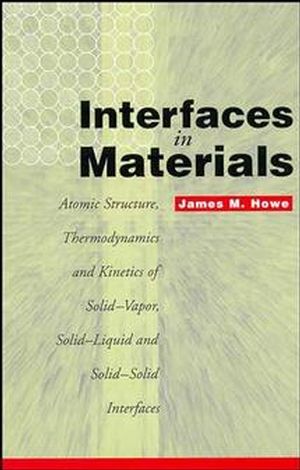Interfaces in Materials: Atomic Structure, Thermodynamics and Kinetics of Solid-Vapor, Solid-Liquid and Solid-Solid InterfacesISBN: 978-0-471-13830-3
Hardcover
544 pages
February 1997
 This is a Print-on-Demand title. It will be printed specifically to fill your order. Please allow an additional 10-15 days delivery time. The book is not returnable.
|
||||||
A thorough exploration of the atomic structures and properties ofthe essential engineering interfaces--an invaluable resourcefor students, teachers, and professionals
The most up-to-date, accessible guide to solid-vapor,solid-liquid, and solid-solid phase transformations, thisinnovative book contains the only unified treatment of these threecentral engineering interfaces. Employing a simple nearest-neighborbroken-bond model, Interfaces in Materials focuses on metal alloysin a straightforward approach that can be easily extended to alltypes of interfaces and materials. Enhanced with nearly 300illustrations, along with extensive references and suggestions forfurther reading, this book provides:
* A simple, cohesive approach to understanding the atomicstructure and properties of interfaces formed between solid,liquid, and vapor phases
* Self-contained discussions of each interface--allowingseparate study of each phase transformation
* A comparative look at the different interfaces, includingatomic structure and crystallography; anisotropy, roughening, andmelting; interfacial stability and segregation; continuous andledge growth models; and atomistic modeling
* An analysis of nearest-neighbor broken-bond results againstthermodynamic and kinetic descriptions of the interfaces
* Problem sets at the end of each chapter, emphasizing the keyconcepts detailed in the text
Spanning the fields of chemical, electrical and computerengineering, materials science, solid-state physics, andmicroscopy, Interfaces in Materials bridges a major gap in theliterature of surface and interface science.
The most up-to-date, accessible guide to solid-vapor,solid-liquid, and solid-solid phase transformations, thisinnovative book contains the only unified treatment of these threecentral engineering interfaces. Employing a simple nearest-neighborbroken-bond model, Interfaces in Materials focuses on metal alloysin a straightforward approach that can be easily extended to alltypes of interfaces and materials. Enhanced with nearly 300illustrations, along with extensive references and suggestions forfurther reading, this book provides:
* A simple, cohesive approach to understanding the atomicstructure and properties of interfaces formed between solid,liquid, and vapor phases
* Self-contained discussions of each interface--allowingseparate study of each phase transformation
* A comparative look at the different interfaces, includingatomic structure and crystallography; anisotropy, roughening, andmelting; interfacial stability and segregation; continuous andledge growth models; and atomistic modeling
* An analysis of nearest-neighbor broken-bond results againstthermodynamic and kinetic descriptions of the interfaces
* Problem sets at the end of each chapter, emphasizing the keyconcepts detailed in the text
Spanning the fields of chemical, electrical and computerengineering, materials science, solid-state physics, andmicroscopy, Interfaces in Materials bridges a major gap in theliterature of surface and interface science.



